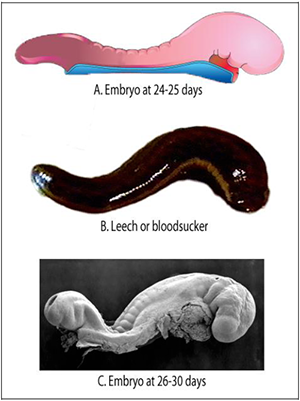𝐒𝐮𝐫𝐞𝐥𝐲 𝐭𝐡𝐞 𝐐𝐮𝐫’𝐚𝐧𝐢𝐜 ‘𝐀𝐥𝐚𝐪𝐚𝐡 (𝐭𝐡𝐞 𝐞𝐦𝐛𝐫𝐲𝐨 𝐝𝐮𝐫𝐢𝐧𝐠 𝐭𝐡𝐞 𝐥𝐞𝐞𝐜𝐡-𝐥𝐢𝐤𝐞 𝐬𝐭𝐚𝐠𝐞) 𝐢𝐬 𝐞𝐚𝐬𝐢𝐥𝐲 𝐨𝐛𝐬𝐞𝐫𝐯𝐞𝐝 𝐰𝐢𝐭𝐡 𝐭𝐡𝐞 𝐧𝐚𝐤𝐞𝐝 𝐞𝐲𝐞?
Mohamad Mostafa Nassar
Twitter:@NassarMohamadMR

‘Alaqah is a stage in the development of the human embryo. One of the meanings of the term ‘alaqah is a leech. If you examine the illustrations above, you clearly see that the shape of the embryo does in fact resemble a leech.
‘Alaqah refers to the embryo when it is extremely small. Due to the small sizes involved scientists could not have recognised the detailed features of the ‘alaqah stage:
It is remarkable how much the embryo of 23-24 days resembles a leech. As there were no microscopes or lenses available in the 7th century, doctors would not have known that the human embryo had this leech-like appearance. In the early part of the fourth week, the embryo is just visible to the unaided eye because it is smaller than a kernel of wheat.[1]
Prior to the advent of the compound microscope, there existed no means to observe the early stages of human development. Even after the invention of the microscope, several scientists around 1720 claimed to have observed under the microscope extremely minute forms of men complete with arms, heads and legswithin human spermatozoa.
Another scientist insisted that he had seen a minute horse in the semen of a horse, a similar creature but with very long ears in the semen of a donkey, and tiny cockerels in the semen of a cock! Inadequate observation or faulty experiment led to many false theories.[2]
So, when would the human embryo then be visible to the unaided eye? Prof. Keith L. Moore, who has studied many early embryos, says:

I guess it depends on how good your eyes are. But if you have normal eyesight you should be able to see it around 22-23 days when it’s just about the size of a kernel of what. But without a magnifying glass or without some microscope you wouldn’t be able to see the details that we’ve shown you.
As Dr. Persaud said, when they were talking about the ‘alaqah leech-like substance certainly they were not able to see that embryo – even if they opened the uterus to look at it – it would be so small. And I’ve seen them, it’s just a little white spot. It’s only when you put a magnifying glass to it that you can actually see these details that make it look like a leech.
So they certainly didn’t have that knowledge and I would say you can’t see it up until after three weeks.[3]
Similarly, Professor Marshall Johnson[4] states:
You have to be really careful on what is the definition of ‘seeing’. I can see a piece of dandruff on this tabletop; I can just barely make it out because this is a nice black surface [but] I can see no detail in it. If I want to see detail in it then I need some sort of visual aid, something to aid my vision, I need a magnifying glass, I need a microscope. So I might be able to see a piece of dandruff, but to see any detail in it as is described in the Qur’an, I need an instrument that wasn’t developed until the 1700s.[3]
It is even more remarkable if we consider that not only is the embryo extremely small (about 3.5mm), but that this “leech-like” appearance lasts only for a very short period of time, perhaps four to five days or so. This makes even modern observation of this likeness during this period extremely difficult.
For more information, please see the paper Embryology in the Qur’an: The ‘Alaqah Stage where the term Qur’anic ‘alaqah is described in detail.
NOTES
[1] Moore, K.L., A Scientist’s Interpretation of References to Embryology in the Qur’an, Journal of the Islamic Medical Association of North America, Vol. 18, No. 1-2, 1986, p. 16.
[2] Mary J. Seller, Some Fallacies in Embryology Through the Ages, in The Human Embryo: Aristotle and the Arabic and European traditions by G.R. Dunstan, 1990, University of Exeter Press.
[3] Embryology in the Qur’an, Toronto, Canada, 1988 with Keith L. Moore, TVN Persaud and E. Marshal Johnson. Lecture delivered to the Muslim Students Association.
[4] Dr. E. Marshall Johnson, Professor and Chairman of the Department of Anatomy and Developmental Biology, and Director of the Daniel Baugh Institute, Thomas Jefferson University, Philadelphia, Pennsylvania, USA.
RELATED ARTICLES
- Embryology in the Qur’an: The ‘Alaqah Stage
- Does the embryo resemble a leech in this photo?
- The Stages of Embryological Fabrication by Dr. Lactantius
- Embryology in the Qur’an – Correlation Studies with Modern Embryology
- Video: The Miracle of Life